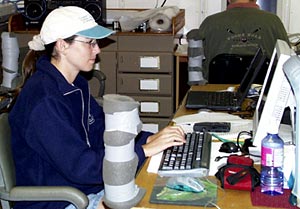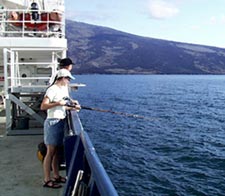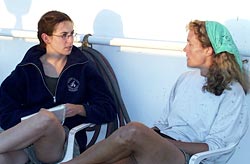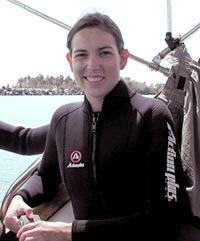|
|
Interviews: Science Writer Christy Reed How and why did you become a science writer? Christy: I was an oceanography student at the University of Washington in Seattle, and taking courses in English literature, when I learned about graduate school in science writing. When I was a junior, my ecology class read the book by Jonathan Wiener, The Beak of the Finch, about the Galápagos, and I did a detailed report on penguins and their evolution. I was inspired by Wiener’s writing style and felt connected to the scientists, and I’ve always wanted to go to the Galápagos. I began thinking seriously about becoming a science writer and applied to the graduate school at Columbia University in Earth and Environmental Science Journalism. I was extremely excited to go to New York. I’d been living on the West Coast my whole life, but had visited New York City as a child. The science writing program at Columbia is fantastic. It’s relatively new. I was in the program’s second graduating class. In the first year, we worked with science graduate students working on their Ph.D.s at Lamont-Doherty Earth Observatory. In the second year, we were students at Columbia's Journalism School. We had to do two master’s projects, one in science and one in science writing. In my first year I went out to sea on the RV Knorr with scientists from LDEO and WHOI and did gravity cores and a multi-corer to investigate the extent of the Little Ice Age. My second project consisted of writing a long feature article about the Asian longhorn beetle, which is attacking maple trees throughout New York City and Chicago. Before I graduated from the J-School, I started working as an intern at Scientific American. I now work as the associate editor at Geotimes Magazine. Geotimes is primarily for earth scientists and people interested in earth science, including students, the public, and professionals. I also freelance when I have time.
What do you have to do to get a Dive and Discover page ready each day? Christy: Every morning I take pictures and interview people about what’s going on that day. In the afternoon, I write up the interview and start working on the daily journal, which I try to get finished around dinnertime. For the rest of the evening, we edit the material for the Web page and work on the slide show, which Kate and Rhian have been putting together during the day. Dan and I generally try to decide topics for the daily journal the day before I write each one. For instance, the engineering article for Sept. 8 was inspired by feedback from students, who sent in questions to the web site about how we make freshwater on the ship. It’s exciting to wake up every day and have something new going on. I’m always at the computer, taking pictures, talking to the crew and scientists, and finding out what’s going on. It’s really exciting that we’re reaching thousands of kids, thousands of future scientists and science writers. Even if the students reading our web site don’t go into science or any related field, they are learning about it and can use that information in whatever career they choose because knowing science can help you understand your world better. Question: What’s the most challenging thing you’ve ever done? Christy: This is the most challenging thing I’ve ever done, being the science writer for Dive and Discover, because it meant going beyond my comfort zone. It means working on a daily deadline, working with a whole new group of people I’d never met before, and going out to sea which I know can be a lot of fun but can also be challenging. I’m gung-ho to do this type of thing more often. For instance, I’d like to do a Dive and Discover project involving coastal studies, to teach students about the relationship between the oceans and the continents. Question: What do you like to do in your spare time? Christy: I’m learning how to river kayak; I’ve sea kayaked in the San Juan Islands and along the west coast of Canada. I also like to roller-blade, bike, snow ski, and sail. I love swing music and swing dancing. When I lived in New York City I used to go swing dancing on top of the World Trade Center. I also like to SCUBA dive.
SCUBA diving must be interesting for someone trained in oceanography. How did you learn how to SCUBA? Christy: When I was about 9 years old, my family and I went to Sea World, in San Diego. They had an exhibit where you could put on a wet suit and wade in a pool with little tiger sharks. Then the pool deepened, and you had to snorkel through a coral reef display with fish. I got terrified, and my brother had to come back and get me because I was still clinging to the side of the exhibit, refusing to go back or forward. The trainers had to crawl through the brush to come take me out because I was so scared. Part of learning to SCUBA dive when I was 14 involved conquering my fear. I went with my family on a trip to Australia where I first used SCUBA equipment. Being down under water was so much different from being above the water snorkeling. I felt in control of what I could see and where I was. So when I was 18, I got certified and I love it. I saw sharks for the first time this year in the Caribbean, black tipped reef sharks and nurse sharks. Sharks are incredibly majestic. My dream experience is to see a whale shark. I’ve been diving in Puget Sound in Washington, and Monterey Bay in California where I swam through the kelp forest and saw a harbor seal close up. I’ve also been diving in Thailand. I’m not afraid of snorkeling anymore and seeing the sea lions swim all around us in Santa Fé Bay in the Galápagos gave me a tremendous thrill.
Tell us a bit about your family. Christy: I grew up in Irvine California. When I was in junior high school my family and I moved to Redmond, Washington. My Dad’s a retired captain from Delta Airlines. Mom has been an interior designer and a real estate agent. And, when they’re not traveling around the world, both my parents love to garden. My younger brother, Bob, is also a pilot, for a subsidiary of Alaska Airlines. I’m very proud of my brother, and I can’t wait to visit him in Alaska so he can take me flying. My family is very important to me. My brother and I grew up with the philosophy that you never really know what to expect next and it’s good to venture out to see what tomorrow might bring. |
||||||||||
Mailing List | Feedback | Glossary | For Teachers | About Us | Contact
© 2010 Dive and Discover™. Dive and Discover™ is a registered trademark of
Woods
Hole Oceanographic Institution

 As the journalist for the Dive and Discover website, Christy spends a lot of time at her computer. Here she is writing the daily journal.
As the journalist for the Dive and Discover website, Christy spends a lot of time at her computer. Here she is writing the daily journal.

